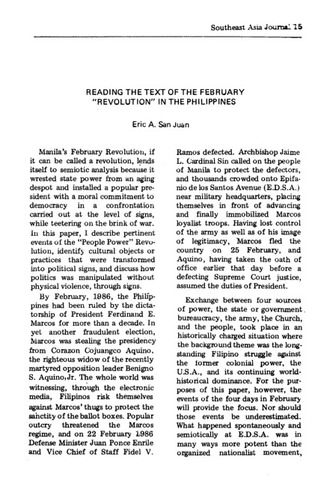Reading the text of the February “revolution" in the Philippines
| dc.contributor.author | San Juan, E. Jr. | |
| dc.date.accessioned | 2023-09-01T02:04:05Z | |
| dc.date.available | 2023-09-01T02:04:05Z | |
| dc.date.issued | 1988 | |
| dc.identifier.issn | 0038-3600 | |
| dc.identifier.uri | https://hdl.handle.net/20.500.12852/2779 | |
| dc.description | Journal article | en_US |
| dc.description.abstract | Manila’s February Revolution, if it can be called a revolution, lends itself to semiotic analysis because it wrested state power from an aging despot and installed a popular president with a moral commitment to democracy in a confrontation carried out at the level of signs, while teetering on the brink of war. In this paper, I describe pertinent events of the “People Power” Revolution, identify cultural objects or practices that were transformed into political signs, and discuss how politics was manipulated without physical violence, through signs. | en_US |
| dc.language.iso | en | en_US |
| dc.publisher | Central Philippine University | en_US |
| dc.subject.lcsh | Revolution (Philippines : 1986) | en_US |
| dc.subject.lcsh | Politics and government | en_US |
| dc.title | Reading the text of the February “revolution" in the Philippines | en_US |
| dc.type | Article | en_US |
| dcterms.accessRights | Publicly accessible | en_US |
| dc.citation.firstpage | 15 | en_US |
| dc.citation.lastpage | 23 | en_US |
| dc.citation.journaltitle | Southeast Asia Journal | en_US |
| dc.citation.volume | 16 | en_US |
| dc.citation.issue | 1 | en_US |
| local.subject | People power | en_US |
Fichier(s) constituant ce document
Ce document figure dans la(les) collection(s) suivante(s)
-
Southeast Asia Journal [188]


